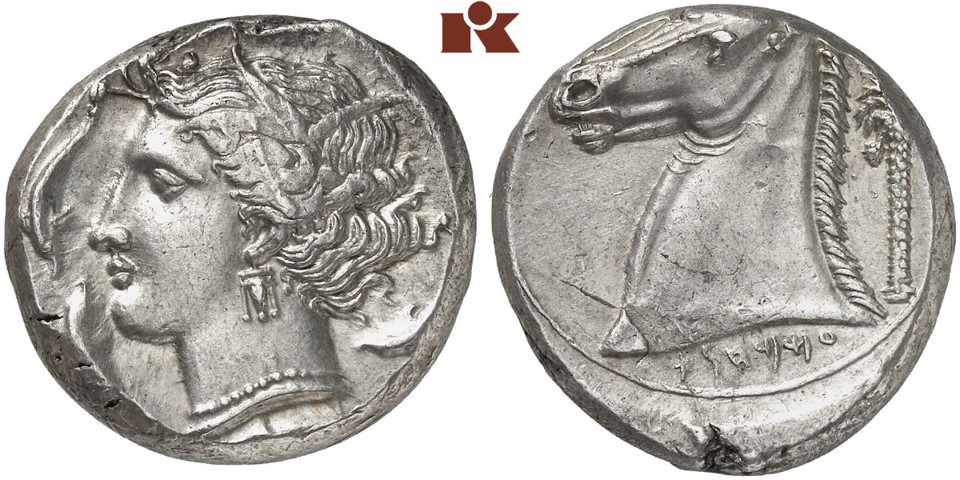309 BCE - 300 BCE | MM in punic characters below the horse's neck
Overstriking coin
Sicile_punique_Künker,_270,_2_Oct._2015,_8152.jpg
[1]
|
|
Sale(s)Sale(s) ᵖ:
|
Rauch, 14 Apr. 2015, 82 = Künker, 270, 2 Oct. 2015, 8152
|
|
|
|
Description
| ObverseInscription or printing placed on the obverse.:
|
Head of Arethusa to left, wearing wreath of grain leaves, triple-pendant earring and pearl necklace, three dolphins swimming around
|
ReverseInscription or printing placed on the reverse.:
|
MM in punic characters below the horse's neck (Punic) Horse head three-quarters to left, palm tree behind to right with two bunches
|
Mint and issuing power
| MintIdentifies the place of manufacture or issue of a numismatic object.:
|
Siculo-Punic (uncertain mint)
|
Ancient regionAncient region.
|
Sicily
|
Modern countryModern country: Italy
|
AuthorityIdentifies the issuing power. The authority can be "pretended" when the name or the portrait of X is on the coin but he/she was not the issuing power. It can also be "uncertain" when there is no mention of X on the coin but he/she was the issuing power according to the historical sources:
|
Carthaginian Empire
|
Chronology
| FromIdentifies the initial date in a range assigned in a numismatic context. 309 BCE toIdentifies the final date in a range assigned in a numismatic context.. 300 BCE
|
Hellenistic 323-30 BC  periodTime period of the numismatic object. periodTime period of the numismatic object.
|
Physical description
MetalThe physical material (usually metal) from which an object is made.: Silver 
|
WeightWeight of the numismatic object (in grams). in grams: 17.0417.04 g <br />17,040 mg <br />
|
DenominationTerm indicating the value of a numismatic object. Examples: tetradrachm, chalkous, denarius.: tetradrachm 
|
|
|
|
StandardStandard.: Attic
|
References
Description
| ObverseInscription or printing placed on the obverse.:
|
|
ReverseInscription or printing placed on the reverse.:
|
|
Mint and issuing power
| MintIdentifies the place of manufacture or issue of a numismatic object. ᵖ:
|
|
Ancient regionAncient region. ᵖ
|
|
Modern countryModern country:
|
AuthorityIdentifies the authority in whose name (explicitly or implicitly) a numismatic object was issued. ᵖ:
|
|
Chronology
| FromIdentifies the initial date in a range assigned in a numismatic context. toIdentifies the final date in a range assigned in a numismatic context..
|
periodTime period of the numismatic object.
|
Physical description
References
References
- ^ Jenkins, Gilbert Kenneth (1978), "Coins of Punic Sicily. Part 4. Carthage Series 5-6", Schweizerische numismatische Rundschau, 57, p. 5-68, pl. 1-24.
- ^ Hoover, Oliver D. (2012), The Handbook of Greek Coinage Series. 2. Handbook of the Coins of Sicily (Including Lipara). Civic, Royal, Siculo-Punic, and Romano-Sicilian Issues. Sixth to First Centuries BC, Lancaster-London, 489 p.
- ^ Artru, Jérémy (2024), Carthage : monnaie et histoire, de la prise de Sélinonte à la révolte lybienne (409-237 av. n.-è.), unpublished PhD, Orléans, 1.058 p., 61 pl.

